National Serpent Day – Featuring EnviroScience Snake Services
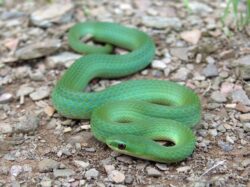 Snake surveys are often performed as part of a terrestrial survey or wildlife inventories at EnviroScience. These surveys effectively detect the presence or absence of endangered, threatened, or rare species at a proposed development project. With the decline of many snake species, more species are likely to soon be listed under the federal Endangered Species Act or state regulations. As this occurs, the importance of snake surveys will only increase.
Snake surveys are often performed as part of a terrestrial survey or wildlife inventories at EnviroScience. These surveys effectively detect the presence or absence of endangered, threatened, or rare species at a proposed development project. With the decline of many snake species, more species are likely to soon be listed under the federal Endangered Species Act or state regulations. As this occurs, the importance of snake surveys will only increase.
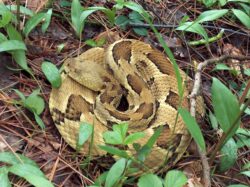 Our experienced herpetologists have scientific collector’s permits or are on state or federal agency lists of qualified rare or listed snake surveyors. Our snake biologists are experts at detecting and tracking reptiles in their diversity of habitats. They use a variety of tools and methods to collect thorough and accurate data. For example, Visual Encounter Surveys (VES) are performed for snakes by searching favorable habitats during the spring and summer months. Specialized traps, such as “box traps” along drift fences and artificial habitats, like cover boards, are designed to document species that are difficult to find during visual surveys.
Our experienced herpetologists have scientific collector’s permits or are on state or federal agency lists of qualified rare or listed snake surveyors. Our snake biologists are experts at detecting and tracking reptiles in their diversity of habitats. They use a variety of tools and methods to collect thorough and accurate data. For example, Visual Encounter Surveys (VES) are performed for snakes by searching favorable habitats during the spring and summer months. Specialized traps, such as “box traps” along drift fences and artificial habitats, like cover boards, are designed to document species that are difficult to find during visual surveys.
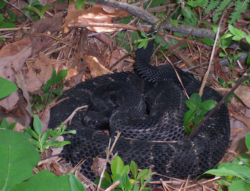 Standard snake survey protocols usually begin with a habitat assessment (Phase I Survey), when our qualified biologists perform a walkthrough and visual search for potential critical snake habitats to evaluate a proposed project area. Critical snake habitat is often considered to be either the potential over-wintering habitat or potential summer-gestating habitat. Also, early spring basking, foraging, and transient habitat may be part of the habitat assessment for certain species.
Standard snake survey protocols usually begin with a habitat assessment (Phase I Survey), when our qualified biologists perform a walkthrough and visual search for potential critical snake habitats to evaluate a proposed project area. Critical snake habitat is often considered to be either the potential over-wintering habitat or potential summer-gestating habitat. Also, early spring basking, foraging, and transient habitat may be part of the habitat assessment for certain species.
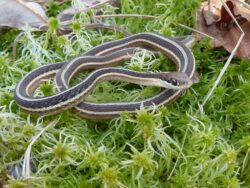 Should potential critical habitat be found during the habitat assessment—and if the critical habitat is difficult to avoid during construction of a project—the next phase of the snake evaluation could be what is called a presence/absence survey (Phase II Survey), which typically involves the search for snakes during their active season and appropriate weather conditions in the potential denning, basking, gestating, or foraging habitat.
Should potential critical habitat be found during the habitat assessment—and if the critical habitat is difficult to avoid during construction of a project—the next phase of the snake evaluation could be what is called a presence/absence survey (Phase II Survey), which typically involves the search for snakes during their active season and appropriate weather conditions in the potential denning, basking, gestating, or foraging habitat.
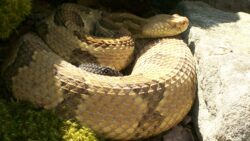 Another type of snake service (especially for venomous snakes) that EnviroScience provides is called “snake construction monitoring.” This service entails the presence of a permitted snake biologist on an active construction site during the active season of the snake species. For the safety of workers (when venomous snakes are present) and snakes, our biologists are on-site before and during construction to inspect and clear the project area (including staging areas and access roads) of snakes and to capture and remove any snakes that may interfere with work activities.
Another type of snake service (especially for venomous snakes) that EnviroScience provides is called “snake construction monitoring.” This service entails the presence of a permitted snake biologist on an active construction site during the active season of the snake species. For the safety of workers (when venomous snakes are present) and snakes, our biologists are on-site before and during construction to inspect and clear the project area (including staging areas and access roads) of snakes and to capture and remove any snakes that may interfere with work activities.
Our snake biologists perform surveys for all of the threatened, endangered, or special concern species listed below:
- Timber Rattlesnake (Crotalus horridus)
- Kirtland’s Snake (Clonophis kirtlandii)
- Copper-bellied Watersnake (Nerodia erythrogaster neglecta)
- Lake Erie Watersnake (Nerodia sipedon insularum)
- Smooth Greensnake (Opheodrys vernalis)
- Rough Greensnake (Opheodrys aestivus)
- Eastern Massasauga (Sistrurus catenatus)
- Plains Gartersnake (Thamnophis radix)
- Queen Snake (Regina septemvittata)
- Northern Copperhead (Agkistrodon contortrix mokasen)
- Northern Pine Snake (Pituophis melanoleucus)
- Corn Snake (Pantherophis gutatta)
Click here for more information on EnviroScience Reptile and Amphibian Surveys.
Few environmental firms in the country retain EnviroScience’s degree of scientific know-how, talent, and capability under one roof. The diverse backgrounds of our biologists, environmental engineers, scientists, and divers enable us to provide comprehensive in-house services and an integrated approach to solving environmental challenges—saving clients time, reducing costs, and ensuring high-quality results.
Our client guarantee is to provide “Excellence in Any Environment” meaning no matter what we do, we will deliver on our Core Values of respect, client advocacy, quality work, accountability, teamwork, and safety. EnviroScience was created with the concept that we could solve complex problems by empowering great people. This concept still holds true today, as our scientists explore the latest in environmental legislation and regulations and incorporate the most up-to-date technology to gather and report data.
EnviroScience expertise includes but is not limited to: aquatic survey (including macroinvertebrate surveys and biological assessments); ecological restoration; ecological services (including impact assessments, invasive species control, and water quality monitoring); emergency response; engineering and compliance services; endangered mussel surveys; laboratory and analysis; stormwater management; threatened and endangered species; and wetlands and streams (including delineation and mitigation). Further, EnviroScience is one of the few biological firms in the country that is a general member of the Association of Diving Contractors International (ADCI) and offers full-service commercial diving services.